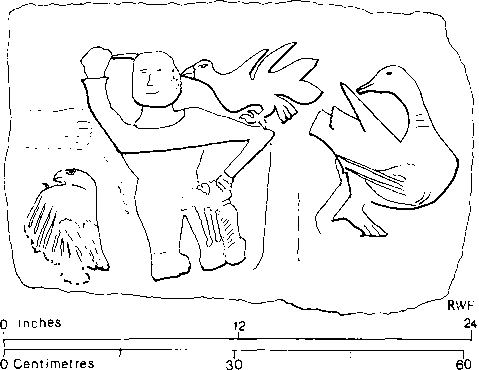It is clear that animals were ritually slain for sacrificial purposes; there is much evidence both textual and archaeological for this widespread practice. Some of the most interesting examples of animal sacrifice come from Gaelic Scotland, where traditions of a clearly archaic nature have survived in remote and rural Celtic contexts. One of these, much abhorred by the church, persisted at least into the late eighteenth century. It took place in the month of August on Inis Maree, a little island “in the loch of that name in Ross and Cromarty. The island is sacred to the saint Maelrubha. Clearly a Lughnasa ceremony, it consisted of sacrificing bulls to the saint by the people of the region. An Invaluable account of this and other ‘heathenish practices’ is contained in the Dingwall Presbytery Records of 6 August 1778 (Mitchell 1862: 8-10, quoted in MacNeill 1962: 364 and in MacCulloch 1911:
Pliny, in his famous description of the culling of mistletoe by the druids before a feast {Naturalis Historia XVI.249), states: ‘Having made preparation for a sacrifice and a banquet beneath the trees, they bring thither two white bulls, whose horns are bound then for the first time. . .. Then they kill the victims.’ In Ireland a bull-feast, tarh-feis, was used to determine by mantic means the rightful successor to the king of Tara. A bull was killed, and a druid ate of its flesh and drank of the broth in which it had been cooked. The druids sang a ‘spell of truth’ over him, and in his dreams he would ‘see’ the rightful king. Sometimes the prophet had to be wrapped in the hide of the slaughtered animal. The ritual slaughter of three bulls seems to be taking place on an inner plate of the Gundestrup Cauldron, where three warriors hold swords to the throats of huge animals, their immense size in comparison to the men suggesting their own divinity. Three surly dogs bound beneath the animals (Olmsted 1979: pi. 3D) (Figure 23.4).
The bull, and bovines in general, seem to have been regular sacrificial animals, and to have been included in the choice of animals thrown into the straw colossi and immolated, according to Strabo (Geographica IV.4.C.198.5). Brunaux mentions bovine sacrifice on a large scale revealed in the excavations of places such as Gournay, in Picardy, France, where the remains were deposited in a central pit (Brunaux 1988: 15, etc.).
There can be little doubt that animal sacrifice took place in Ireland at the great assemblies, as did human sacrifice. At the druidic site Uisnech, traces of the Beltain sacrifices have been found. In the centre of the enclosure on the top of the hill a large bed of ashes was exposed, relics of a series of fires, and charred skeletons of animals were found among them (Macalister 1931: i66ff.). Ann Woodward states in her Shrines and Sacrifice (1992: 78):
It can be assumed that many of the sacrificed beasts would have provided meat for feasting, so the numbers of bodies and parts of bodies that have survived on Iron Age sites indicate that the practice of animal sacrifice in Celtic society must have been very widespread indeed.
All the evidence supports this statement. Cunliffe’s discovery of the heads and legs of horses in various contexts at Danebury, Hampshire, is suggestive of the ‘heads and hooves’ ritual where the body of the animal was consumed and the hide used to wrap the seer in preparation for his mantic sleep (1968: i55ff.).
Pigs were choice animals for sacrifice and ritual consumption, and the pig heads in the Yorkshire iron age graves are indicative of this (Stead 1979: passim), as too is the scene on the Epona relief (Figure 23.5). A divinatory rite in early Ireland, recorded by Cormac, bishop of Cashel, In the ninth century, involved a process known as Imbas Forosnai, ‘Knowledge that Enlightens’:
The fili chews a piece of the flesh of a red pig, or of a dog or a cat, and puts It afterwards on a flagstone behind the door, and pronounces an incantation on it, and offers it to idol gods.

Figure 23.4 Incomplete bronze implement, probably a flesh-fork, ornamented with a pair of ravens and two swans with three cygnets. Dunavcrncy, Co. Antrim, Ireland. (R. Megaw and V. Megaw, Celtic Art, London 1989: 25, fig. 9.)

Figure 23.5 Epona with seven ponies, a tree-stump borne on a cart drawn by three horses, and two priests about to sacrifice a young boar which one priest holds by the back legs. Bcihingcn, Stuttgart, Germany. (E. Esperandieu, Recueil general des bas-reliefs, statues et busies de la Germanie romaine, Paris and Brussels 1931: 404.)
Dog sacrifice is well attested archaeologically. Danebury produced several examples of this (Cunliffe 1968: 155!.), and there are numerous other occurrences of ritual deposits in Britain which contain the remains of dogs. At the religious site of Ivy Chimneys, Essex, a ditch contained dog teeth arranged in the form of a necklace. In the Upchurch Marshes, Kent, puppies were found buried in urns, one with an adult bitch; and these are paralleled by the pots containing dogs and dating to the pre-Roman Iron Age and earlier, which have been found in Jutland. Some of the bones were in pots, and some scattered generously round these (Todd 1975: i97ff.: for dog sacrifice, see Green 1986; 155, 168, 176). The shaft, with a depth of 200 ft (61 m), at the Romano-British shrine at Muntham Court, Sussex, contained a great many dog skeletons. The shrine is dated to the first century.
Animal sacrifice was much favoured by the Celts and the Germanic peoples alike, and the custom long persisted in the Celtic world, where, for example, one animal would be ritually slain in order to preserve the flock or herd from some decimating disease. Henderson (1911: 271-2) gives a personal account of such a custom;
I well recollect how in the Highlands, when any loss occurred among the cattle in spring (earchall) the hooves and sometimes the head or parts of it were taken away to the wood and buried secretly in the soil under the great trees where nobody could possibly molest them. It was still better to bury them on an adjoining estate, and across a river. This was to put away the earchall and to prevent the loss of more animals. In some of the Isles there is still a memory of a cure for a species of cattle-plague. .. . The old people said if the heifer’s head were struck off at a single blow with a clean or stainless sword that the plague would cease.. . this was done in the eighteenth century.
In Wales, according to the Revd John Evans in 1812, ‘when a violent disease breaks out among the horned cattle, the farmers.. . give up a bullock for a victim, which is carried to the top of a precipice whence it is thrown down’ (ibid.).
Celtic sacrifice, human and animal, is indeed well attested. More integral to druidism and to Celtic religion in general is the custom of deposition, which has a long ancestry in Europe. This was carried out into the earth, through which the deities could be reached in their Otherworld, known as Annwn or Annwfn and sited beneath the earth {dwfn) according to Welsh tradition. In Irish belief this subterranean Elysium was situated through the sidh (Otherworld) mounds, down wells or beneath lakes and pools or in rivers. The Celts did not love their deities; they made contracts with them as they did in their own society. By making offerings into pits, wells, springs, peat-bogs and all watery places, no doubt with solemn attendant ritual, the druids were in fact ‘binding’ the gods into making reciprocal gifts to mankind - including, no doubt, security against their own hostility (Figure 23.6).
A votive and, perhaps, sacrificial deposit, comprising four magnificent horns decorated with La Tene patterns and accompanied by human skulls, was recovered from Loughnashade, the lough which in all probability was connected with the nearby royal and sacred stronghold of Emain Macha, Navan Fort near Armagh, Ireland. Sacred places elsewhere in the Celtic world are often associated with lakes and pools. Here the whole surrounding landscape would seem to have been devoted to ritual, and the huge 130 ft (40 m) circular wooden structure - a kind of artificial oak grove, perhaps - destroyed by burning in 95 or 94 BC, provides evidence of druidic activity and ritual on an unprecedented scale. It must indeed be regarded as one of the most important religious iron age sites in Europe. It is contemporary with the traditions of the Ulster Cycle, with the Chamalieres defixio, and with comments on the Celts and their religion by Poseidonios and, later, Caesar.
In an important article in Emania (1992; 41), C. J. Lynn asks:
Who was the organiser, the master-mind, the motivator and the interpreter of this series of events? Who knew the secrets of the gods? Clearly there was a specialist in religious beliefs and practices supervising the building of the Navan ritual construct. ... It is reasonable to claim that ‘historic’ Druids (or a Druid) as described by Caesar were responsible for the initiation, planning, philosophy, specialist knowledge, supervision and religious organisation of this ritual sequence. Their supervision of the construction of a magico-religious, oak-post structure is particularly appropriate given that their name could well mean ‘oak-wise’.

Figure 23.6 Very eroded relief of a beardless male, possibly a druid, holding up a knife in the right hand and with a small creature, a lamb or a young boar, in the left hand. A raven perched on the left shoulder addresses the socket which presumably once held the left ear; a goose turns to look back at the male from his left, while an eagle stands beside his right leg. Sault, Vaucluse, France. (E. Esperandieu, Recueil general des bas-reliefs de la Gaule romaine I,
Ireland has long been thought to be a microcosm of the early Celtic world. It may well be that the Navan story, together with the many other Important excavations of iron age sites in Ireland, will put the study of druidism and early Celtic religion In general on a new footing, and permit a fresh consideration of classical comments and archaeological discoveries both achieved and to come.




 World History
World History









